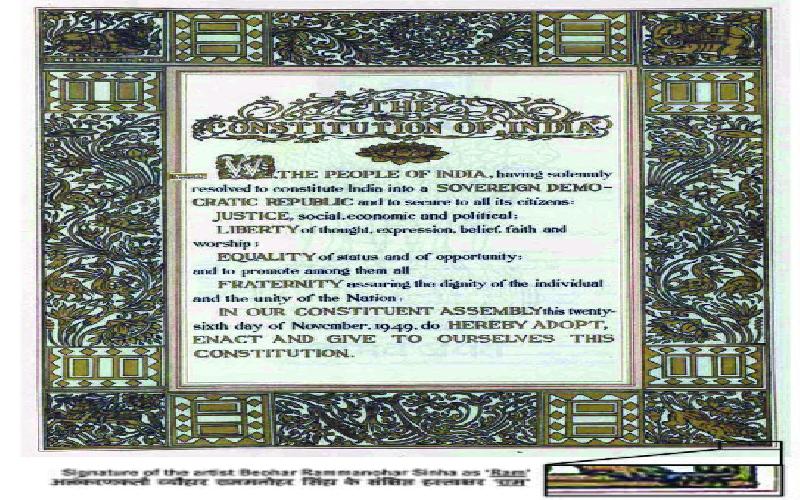Constitution is one of the most important parts of the modern Political States. Its importance lies in laying down the goals and aspirations of State policy, the ideologies that underlie its organizations and their functioning, and the basic political structure which the State represents. It signifies the social contract under which people accept to be governed by the authorities that make the Government. Thus, it is one of the most important documents in public policy, law and administration.
India as a civilization has been in existence since several thousand years, long before documented history can take us. But the existing Republic
of India, with its existing political boundaries, came into existence with the Constitution of India on 26 January, 1950. While there can be no doubt that a large part of the lives of Indian citizens is still governed by their civilization, it is also true that a significant part of their public life, especially relating to matters of the State authority, are significantly affected by the features of the Constitution. Many of its features are as unique as its civilization, and lead to the evolution of a new country with an equally unique character.History of the Constitution of India
Subsequent to the proclamation of the Indian independence, as formalized by the Indian Independence Act, 1947, a Constituent Assembly consisting originally of 389 members was elected by the elected members of provincial assemblies, and held its first meeting on 9 December, 1946. The Constituent Assembly took a little less than three years – two years, eleven months and eighteen days to be precise - to complete the task of drafting the new Constitution of the new Republic. Its work spanned eleven sessions and 166 working days. The drafting was initiated by Sir Benegal Narsing Rao (or B. N. Rao), the Consitutional Adviser, and later undertaken by a Drafting Committee headed by B. R. Ambedkar, who is largely credited with many of its features. The Drafting Committee, constitued on 14 August, 1947 prepared and tabled an initial draft on 4 November, 1947 which was then deliberated for next two years, with consideration on over 2000 amendments and finally adopted by the Constituent Assembly on 26 November, 1949. Every year, the day of 26 November is celebrated as the Constitution Day or the National Law Day, in commemoration of this event.
The Dominion of India, which came into existence by the Indian Independence Act, 1947, was still headed by the British Monarch, and was a part of the British Commonwealth. However, with the coming into effect of the Constitution of India on 26 January, 1950, India became a Republic, with the elected President becoming the constitutional Head of the State.
Unique Features
The Constitution of India is unique in many ways. While some of these unique features may appear to be more of form, most of them also make substantial contributions to the functioning of the State and have an ever lasting impact on the Indian polity. They indicate a very ambitious approach on part of those who wrote it and also tell us a lot about the aspirations that they may have had for the new Republic. Many of these features also result from the balancing act that they must have been faced with, balancing modernity with tradition, the interests of rich with poor, urban with rural, majority with minority, males with females and so on. What is equally interesting, is the fact, that new unique features have continued to be added to it by its amendments and interpretation, after it came into force.
Longest & Most Amended Living Constitution of a Sovereign State
Since 1990, the Indian Constitution holds the privileged position of being the longest living Constitution of a sovereign State or country, with around 145,000 words organized in the form of a Preamble, 25 Parts, 448 Articles, 12 Schedules and 5 Appendices. Before 1990, the longest Constitution was that of Yugoslavia. Among existing Constitutions, only the State of Alabama, which is a State of the United States, but not a sovereign country, has a longer Constitution, with over 300,000 words. Ironically, Great Britain, which dominated politically over India prior to its independence in 1947, does not have a single codified Constitution.
However, it seems that Indians are still not fully satisfied with this lengthy Constitution, and want more. The result is that the Constitution of India is also the most frequently amended Constitution in the World with 101 amendments, the last of which came about in September, 2016. The frequent amendments can be indicative of the dynamic nature of the Constitution, but also reflect the large number of rules it lays down, and which need to be frequently fine tuned.
Ultimate Power in the Hands of the People
One of the most characteristic features of the Indian Constitution is that it places the ultimate power in the hands of the people of India. This is reflected by the opening words in the Preamble, which say:
WE, THE PEOPLE OF INDIA, having solemnly resolved to constitute India into a SOVEREIGN, SOCIALIST, SECULAR, DEMOCRATIC REPUBLIC and to secure to all its citizens:
JUSTICE, social, economic and political;
LIBERTY of thought, expression, belief, faith and worship;
EQUALITY of status and of opportunity; and to promote among them all
FRATERNITY assuring the dignity of the individual and the unity and integrity of the Nation;
IN OUR CONSTITUENT ASSEMBLY this 26th day of November, 1949, do HEREBY ADOPT, ENACT AND GIVE TO OURSELVES THIS CONSTITUTION
The Preamble is recognition of final and ultimate sovereignty of the people over their territory and resources, and a collective free will, by which they bring a new Republic into existence. In as much as the Constitution gives rise to a new country, the words “We, the people of India” document that the new Republic brought into existence on 26 January, 1950 is only a continuation of the civilization that was recognized as India, since times immemorial, and its people have now decided to adopt a new set of rules that will govern the authorities of their new State. The Preamble makes it clear what the new State would be like – it would be a sovereign, socialist, secular, democratic Republic, which would aspire for justice, liberty, equality and fraternity. The word ‘socialist’ and ‘secular’ were added by the 42nd amendment in 1976.
Mix of Unitary and Federal Characteristics
The Indian Constitution is neither completely unitary, nor perfectly Federal. In fact, it has features of both.
Instead of giving rise to a single State, it gives rise to a Union of States – which is a basic feature of Federal systems, with a separate legislature and executive for them, and a clear distinction of powers between them. The Indian States are not subordinate to the Union, and they have a right to exercise powers allocated to them by the Constitution without any interference from the Union Government.
However, the Constitution does not go all the way to create a fully Federal State. Unlike the American States, each of which is entitled to have its own Constitution, Indian States are governed exclusively by the Constitution of India. Unlike the United States, there is only single citizenship in India, and every person in India is considered only a citizen of India. These strong unitary features are further bolstered by the existence of a single unified Judiciary, all India Civil Services manning Governments of both the Union and the States, appointment of the Governor of States by the President, the emergency powers of the Union over the States, and the relatively larger share of powers given to the Parliament in making amendments to the Constitution.
Together, they give rise to a unique quasi-federal system.
Combination of Fundamental Rights, Directive Principles of State Policy & Fundamental Duties of Citizens
Most modern Constitutions guarantee certain fundamental rights to their citizens. Part III of the Constitution of India, which appears to be inspired by the United States Constitution in this regard, also details the fundamental rights of the citizens of India that cannot ordinarily be taken away by anyone, including the Government. However, what makes Indian Constitution unique is the balancing of these fundamental rights with two additional concepts, the Directive Principles of State Policy, taken from the Irish Constitution and the Fundamental Duties of the Citizens, taken from the Constitution of the erstwhile Soviet Union. This combination is one of the most unique features of Indian Constitution.
Judicial Doctrine of Basic Features of Constitution
Like many other Constitutions, Indian Constitution also has a reasonable balance of rigidity and flexibility, since the process of amendment of Constitution is made a little more difficult compared to the process of statutory amendments. However, what has now become a unique feature of the Indian Constitution is the evolution of a judicial doctrine that though any part of the Constitution, including the Preamble, can be amended, such amendments cannot change the basic features of the Constitution, which include Constitutional supremacy, republican and democratic forms, secular character, federal system and separation of powers. This doctrine has been laid by the Supreme Court of India in the famous Kesavanand Bharti case (1973), and is considered unique in the universe of constitutional law.
These are, of course not the only unique features of Indian constitution, but they are enough to tell us why Indian Constitution is so unique among its peers!











